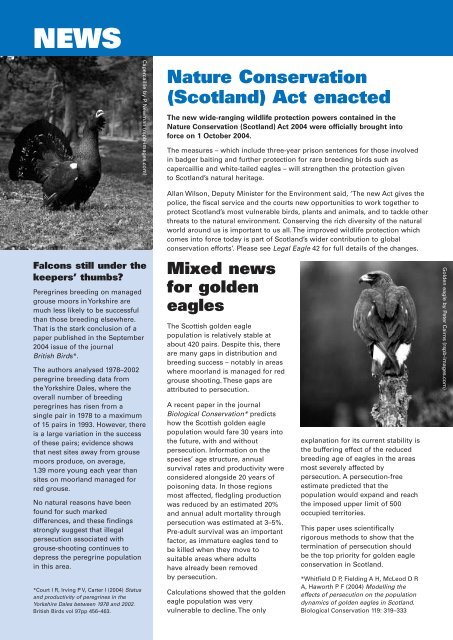Legal eagle 43 - RSPB
Legal eagle 43 - RSPB
Legal eagle 43 - RSPB
Create successful ePaper yourself
Turn your PDF publications into a flip-book with our unique Google optimized e-Paper software.
NEWS<br />
Falcons still under the<br />
keepers’ thumbs?<br />
Peregrines breeding on managed<br />
grouse moors in Yorkshire are<br />
much less likely to be successful<br />
than those breeding elsewhere.<br />
That is the stark conclusion of a<br />
paper published in the September<br />
2004 issue of the journal<br />
British Birds*.<br />
The authors analysed 1978–2002<br />
peregrine breeding data from<br />
the Yorkshire Dales, where the<br />
overall number of breeding<br />
peregrines has risen from a<br />
single pair in 1978 to a maximum<br />
of 15 pairs in 1993. However, there<br />
is a large variation in the success<br />
of these pairs; evidence shows<br />
that nest sites away from grouse<br />
moors produce, on average,<br />
1.39 more young each year than<br />
sites on moorland managed for<br />
red grouse.<br />
No natural reasons have been<br />
found for such marked<br />
differences, and these findings<br />
strongly suggest that illegal<br />
persecution associated with<br />
grouse-shooting continues to<br />
depress the peregrine population<br />
in this area.<br />
*Court I R, Irving P V, Carter I (2004) Status<br />
and productivity of peregrines in the<br />
Yorkshire Dales between 1978 and 2002.<br />
British Birds vol 97pp 456–463.<br />
Capercaillie by P Newman (rspb-images.com)<br />
Nature Conservation<br />
(Scotland) Act enacted<br />
The new wide-ranging wildlife protection powers contained in the<br />
Nature Conservation (Scotland) Act 2004 were officially brought into<br />
force on 1 October 2004.<br />
The measures – which include three-year prison sentences for those involved<br />
in badger baiting and further protection for rare breeding birds such as<br />
capercaillie and white-tailed <strong>eagle</strong>s – will strengthen the protection given<br />
to Scotland’s natural heritage.<br />
Allan Wilson, Deputy Minister for the Environment said, ‘The new Act gives the<br />
police, the fiscal service and the courts new opportunities to work together to<br />
protect Scotland’s most vulnerable birds, plants and animals, and to tackle other<br />
threats to the natural environment. Conserving the rich diversity of the natural<br />
world around us is important to us all. The improved wildlife protection which<br />
comes into force today is part of Scotland’s wider contribution to global<br />
conservation efforts’. Please see <strong>Legal</strong> Eagle 42 for full details of the changes.<br />
Mixed news<br />
for golden<br />
<strong>eagle</strong>s<br />
The Scottish golden <strong>eagle</strong><br />
population is relatively stable at<br />
about 420 pairs. Despite this, there<br />
are many gaps in distribution and<br />
breeding success – notably in areas<br />
where moorland is managed for red<br />
grouse shooting. These gaps are<br />
attributed to persecution.<br />
A recent paper in the journal<br />
Biological Conservation* predicts<br />
how the Scottish golden <strong>eagle</strong><br />
population would fare 30 years into<br />
the future, with and without<br />
persecution. Information on the<br />
species’ age structure, annual<br />
survival rates and productivity were<br />
considered alongside 20 years of<br />
poisoning data. In those regions<br />
most affected, fledgling production<br />
was reduced by an estimated 20%<br />
and annual adult mortality through<br />
persecution was estimated at 3–5%.<br />
Pre-adult survival was an important<br />
factor, as immature <strong>eagle</strong>s tend to<br />
be killed when they move to<br />
suitable areas where adults<br />
have already been removed<br />
by persecution.<br />
Calculations showed that the golden<br />
<strong>eagle</strong> population was very<br />
vulnerable to decline. The only<br />
explanation for its current stability is<br />
the buffering effect of the reduced<br />
breeding age of <strong>eagle</strong>s in the areas<br />
most severely affected by<br />
persecution. A persecution-free<br />
estimate predicted that the<br />
population would expand and reach<br />
the imposed upper limit of 500<br />
occupied territories.<br />
This paper uses scientifically<br />
rigorous methods to show that the<br />
termination of persecution should<br />
be the top priority for golden <strong>eagle</strong><br />
conservation in Scotland.<br />
*Whitfield D P, Fielding A H, McLeod D R<br />
A, Haworth P F (2004) Modelling the<br />
effects of persecution on the population<br />
dynamics of golden <strong>eagle</strong>s in Scotland.<br />
Biological Conservation 119: 319–333<br />
Golden <strong>eagle</strong> by Peter Cairns (rspb-images.com)
















